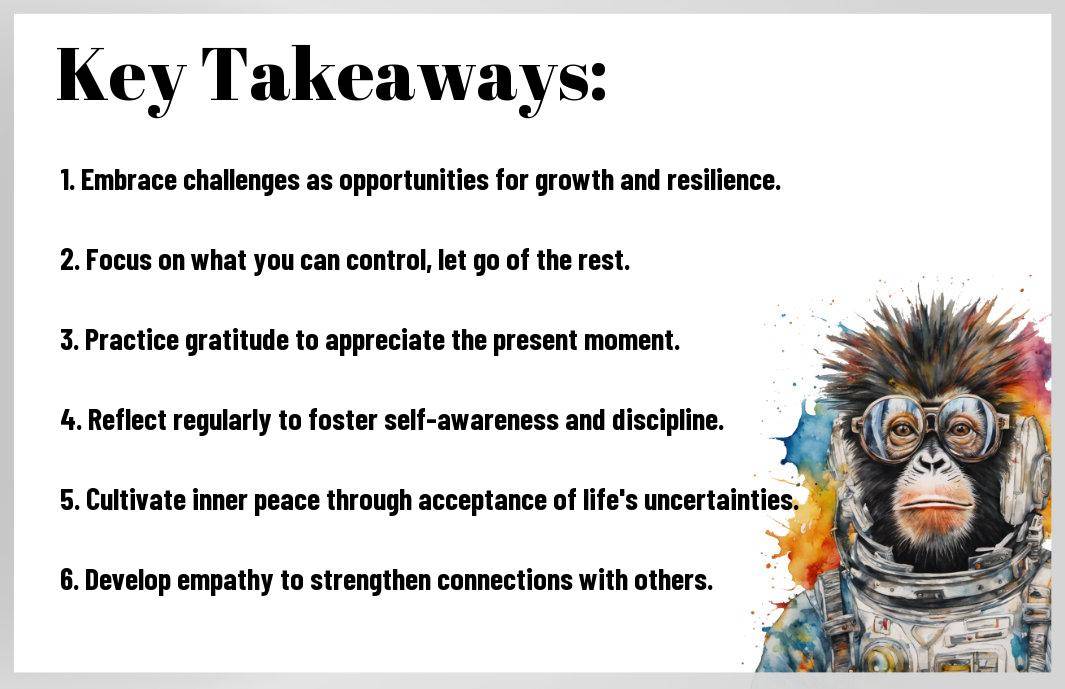There’s so much we can learn from the philosophy of Stoicism, especially when it comes to navigating the ups and downs of daily life. I believe that taking time for daily reflections can help you cultivate resilience, emotional balance, and a deeper understanding of yourself. In this post, I’ll share some practical daily reflections that can guide you toward a more stoic mindset, empowering you to face challenges with clarity and confidence. Let’s explore how these simple practices can transform your perspective and enrich your life.
Key Takeaways:
- Mindfulness: Practice being present in the moment to enhance self-awareness and clarity.
- Control: Focus on what you can control and let go of what you can’t to reduce stress.
- Perspective: Cultivate a broader view of challenges to transform obstacles into opportunities for growth.
- Gratitude: Regularly acknowledge and appreciate the positives in your life to foster a resilient mindset.
- Reflection: Engage in daily reflection to assess your thoughts and actions, reinforcing your values.
- Virtue: Prioritize living virtuously by aligning actions with principles like wisdom, courage, and justice.
- Community: Connect with like-minded individuals to share insights and support each other’s journey towards Stoicism.

Understanding Stoicism
What is Stoicism?
Above all, Stoicism is a philosophy that originated in ancient Greece and emphasizes the importance of rational thinking and self-control. It teaches us that while we cannot control external events, we can control our reactions to them. For me, it’s a lens through which I can view life’s challenges more thoughtfully, fostering resilience so that I can navigate my daily experiences with clarity and calm. Through practicing Stoicism, I strive to align my perception of the world with the reality of it, accepting what is beyond my control while focusing my energy on what I can influence.
The Benefits of a Stoic Mindset
Between the noise of life’s distractions and demands, a Stoic mindset provides a sanctuary for inner peace and strength. Embracing this approach helps me cultivate emotional resilience and mental clarity. I find that when I adopt a Stoic perspective, it empowers me to respond to life’s adversities without being overwhelmed by them. Instead of feeling stressed or anxious about things I can’t change, I approach challenges with a sense of intentionality and purpose. This shift not only enhances my well-being but also transforms how I interact with others and the world around me.
And what I’ve come to realize is that the benefits extend far beyond a simple feeling of well-being. The Stoic mindset encourages me to develop a stronger sense of purpose, leading to greater fulfillment in my daily life. As I practice the teachings of Stoicism, I become more focused, make better decisions, and find joy in the present moment. It opens the door to personal growth, inviting me to live a more authentic and virtuous life, mindful of my choices and their consequences.

Daily Reflections to Cultivate Awareness
Now, I find that cultivating awareness is an vital part of building a Stoic mindset. It allows me to engage with my thoughts and feelings, promoting a deeper understanding of myself and the world around me. By taking a few moments each day to reflect on my experiences, I can develop a greater appreciation for the present moment, letting go of distractions that often cloud my judgment and emotional clarity. This practice not only helps me navigate life’s challenges more effectively but also enhances my ability to respond with wisdom and composure. Through these daily reflections, I can aspire to align my actions with my values and desires.
Practicing Mindfulness
Reflections are a powerful tool for enhancing mindfulness in my daily routine. When I practice mindfulness, I immerse myself in the present moment, bringing awareness to my thoughts, feelings, and sensations. This intentional focus helps me to observe my internal dialogue without judgment, allowing me to understand how my mind works and how it influences my behavior. As I become more aware, I learn to recognize triggers that lead to emotional reactions and can then choose to respond rather than simply react. This shift in perspective can empower me, cultivating a sense of control over my experiences and interactions.
Journaling Your Thoughts
Along my journey, I’ve discovered that journaling is an effective way to document my reflections and feelings. I make it a habit to write down my thoughts daily, capturing moments of gratitude, challenges faced, and lessons learned. This practice not only provides clarity but also helps me to process my emotions constructively. As I put pen to paper, I experience a release of thoughts that may otherwise swirl around in my mind, making way for greater peace and presence. By revisiting my journal entries, I gain insights into my growth and areas where I wish to improve.
Due to the consistent practice of journaling, I’ve noticed how it deepens my self-awareness over time. By reviewing past entries, it’s fascinating to see patterns in my thoughts and behaviors that I might have overlooked in the hustle of daily life. This practice underscores the importance of self-reflection and encourages me to actively confront my beliefs and assumptions, paving the way for personal growth and a more grounded Stoic mindset. Ultimately, journaling serves as a mirror, reflecting not only who I am today but also guiding me toward who I aspire to be.

Embracing Challenges with a Stoic Approach
Not every day is easy, and life throws its fair share of challenges our way. I find that embracing these challenges with a Stoic mindset not only strengthens my character but also enriches my journey. Stoicism teaches me that obstacles are not merely setbacks; they are opportunities for growth and development. When I shift my perspective, seeing challenges as a way to enhance my resilience and courage, I am better equipped to handle whatever life presents me with. This approach allows me to cultivate a sense of inner calm and accept situations as they come, rather than resisting or resenting them.
Reframing Obstacles
On my journey to become more Stoic, I’ve learned that reframing obstacles can dramatically change how I experience them. Instead of viewing a setback as a roadblock, I try to see it as a stepping stone toward my goals. This mindset helps me accept difficulties as part of my growth process. When faced with obstacles, I remind myself that these challenges present valuable lessons and insights that I otherwise might overlook. By focusing on what I can learn from a situation rather than what I have lost, I empower myself to meet challenges with curiosity and bravery.
The Power of Resilience
Among the most transformative concepts I’ve encountered in Stoicism is the essence of resilience. Building resilience means nurturing my ability to bounce back from setbacks and carry on despite them. I’ve realized that my responses to life’s challenges define my experience much more than the challenges themselves. It’s about pushing through discomfort and uncertainty, ultimately emerging stronger. Resilience becomes a practiced skill, one that I can develop through consistent reflection and action in the face of adversity.
Due to the unpredictable nature of life, resilience has become an invaluable asset in navigating my daily battles. It’s not just about enduring difficulties, but also about emerging from them with newfound strength and wisdom. I strive to cultivate this resilience by reflecting on past experiences, identifying lessons learned, and applying those insights to my future endeavors. Each challenge I face becomes an opportunity to reinforce my inner strength, continually preparing me for whatever lies ahead.
Cultivating Gratitude
All too often, I find myself caught up in the chaos of daily life, focusing on what’s missing or what could be better. Cultivating gratitude brings a refreshing change to my outlook, helping me celebrate what I have rather than lamenting what I lack. This practice aligns perfectly with the Stoic mindset, encouraging me to appreciate the present moment and the myriad of experiences that shape my life. By embracing gratitude, I create space for joy and contentment, even in the face of challenges.
Daily Gratitude Practices
Against the backdrop of a busy day, I make it a point to carve out moments for gratitude. One of my favorite routines is jotting down three things I’m grateful for each morning. This small act sets a positive tone for my day and reminds me to focus on the abundance, rather than scarcity. Whether it’s a warm cup of coffee or the support of a friend, these reflections help me acknowledge the goodness that exists in my life.
Shifting Perspective
On many occasions, I’ve noticed that my mood can shift dramatically based on my focus—whether I’m dwelling on problems or counting blessings. By consciously shifting my perspective, I open myself up to seeing the silver lining in situations where I might typically feel frustrated. For instance, when I’m stuck in traffic, instead of viewing it as a setback, I can choose to appreciate the extra time I have to listen to a podcast or simply enjoy some music. This intentional shift not only makes my day brighter, but it also fosters resilience and a more Stoic outlook.
Even the smallest moments of gratitude can transform how I perceive the world around me. When I shift my attention away from what irks me and towards what I appreciate, it creates a ripple effect, enhancing my overall mood and productivity. This proactive approach feeds into my Stoic practice, allowing me to embrace life’s ups and downs with grace and equanimity. By continually training my mind to focus on gratitude, I not only enhance my own well-being but also inspire those around me to adopt a similar mindset.
The Role of Community and Relationships
Despite the Stoic principle of self-sufficiency, I find that community and relationships play an necessary role in my journey towards a Stoic mindset. It’s easy to get lost in our individual struggles and challenges, but connecting with others brings a sense of belonging and shared experience. By surrounding myself with supportive individuals who resonate with Stoic values, I can navigate life’s ups and downs while garnering inspiration. As we learn from each other’s journeys, we also reinforce our commitment to living a virtuous life.
Building Supportive Connections
An important aspect of cultivating a Stoic mindset is the relationships I choose to nurture. Engaging with those who uplift and challenge me has been vital. Building supportive connections allows me to discuss my thoughts and feelings openly, helping me to gain new perspectives. This active exchange not only strengthens our bonds but also fosters a deeper understanding of the Stoic philosophy we embrace together.
Engaging with Like-Minded Individuals
To truly cultivate and maintain a Stoic mindset, I have found it beneficial to engage with like-minded individuals. Being around those who share similar values allows me to exchange ideas and reflect on our experiences collectively. These interactions often spark insightful conversations that help me investigate deeper into understanding and applying Stoic principles in my daily life. The more I engage with such individuals, the more equipped I feel to face challenges while remaining grounded in my beliefs.
Community plays a powerful role in reinforcing my Stoic principles. Whether through online forums, local meetups, or book clubs, connecting with others who are on a similar journey brings a unique kind of motivation. The support we provide each other encourages resilience and reminds me that I am not alone in facing the trials of life. Just like I endeavor to uplift those around me, I encourage you to seek out and nurture those supportive relationships that enrich your journey towards a Stoic mindset.
Summing up
Taking this into account, I find that engaging in daily reflections really helps me cultivate a Stoic mindset. Each moment I take to pause, think, and evaluate my experiences brings me a step closer to serenity and clarity. It’s incredibly empowering to realize that while I may not control external circumstances, I can certainly manage my perceptions and reactions to them. I encourage you to embrace this practice as it can lead you towards a more meaningful and purpose-driven life.
If you’re looking for inspiration, I highly recommend exploring Daily Reflections Inspired by Marcus Aurelius for a …. This resource has been invaluable for me as I strive to deepen my understanding of Stoicism and apply its principles daily. Together, let’s continue this journey of growth and self-mastery, transforming our thoughts into powerful tools for living better lives.
FAQ
Q: What are Daily Reflections in the context of a Stoic mindset?
A: Daily Reflections are practices that encourage individuals to take time each day to contemplate their thoughts, actions, and experiences. In the context of a Stoic mindset, this involves evaluating personal behavior through the lens of Stoic principles, focusing on what is within one’s control, and seeking to cultivate virtues such as wisdom, courage, and self-discipline.
Q: How can Daily Reflections help in developing a Stoic mindset?
A: Daily Reflections facilitate self-awareness and mindfulness, allowing individuals to assess their reactions to daily events. By regularly reviewing one’s thoughts and behaviors, individuals can gain insights into how well they are practicing Stoicism, identify areas for improvement, and gradually develop resilience against negative emotions such as anger and frustration.
Q: What techniques can be used for Daily Reflections?
A: There are various techniques for Daily Reflections, including journaling, meditation, and guided contemplation. Journaling can involve writing about daily experiences, feelings, and lessons learned. Meditation may include focusing on Stoic quotes or principles and reflecting on their relevance in daily life, while guided contemplation might involve visualizing specific scenarios and evaluating one’s responses from a Stoic perspective.
Q: Is there a specific time of day that is best for Daily Reflections?
A: While the timing can vary from person to person, many find that early morning and late evening are ideal for Daily Reflections. Early morning reflections can set a positive tone for the day ahead, whereas evening reflections offer an opportunity to analyze the day’s events and learn from them, helping to promote a sense of closure and growth.
Q: What are some common challenges people face when practicing Daily Reflections?
A: Common challenges include finding the time to reflect amidst a busy schedule, experiencing difficulty with self-honesty, and confronting uncomfortable emotions or experiences that arise during reflection. To overcome these challenges, individuals can start with short reflection periods, gradually increasing them over time, and developing a supportive environment that encourages honest and open contemplation.
Q: Can Daily Reflections be integrated with other self-improvement practices?
A: Yes, Daily Reflections can complement various self-improvement practices. For example, they can be combined with goal-setting, mindfulness exercises, or visualization techniques. Integrating reflections with these practices can create a holistic approach to personal development, as they all work together to enhance awareness, intention, and overall well-being.
Q: How can I measure the progress of my Stoic mindset through Daily Reflections?
A: Progress can be measured by identifying specific areas of improvement over time. Keeping a journal can help track thoughts and emotions, noting patterns and changes in responses to challenging situations. Additionally, reflecting on how one’s reactions align with Stoic virtues can provide insights into growth, fostering a deeper understanding of Stoic principles and their application in daily life.



